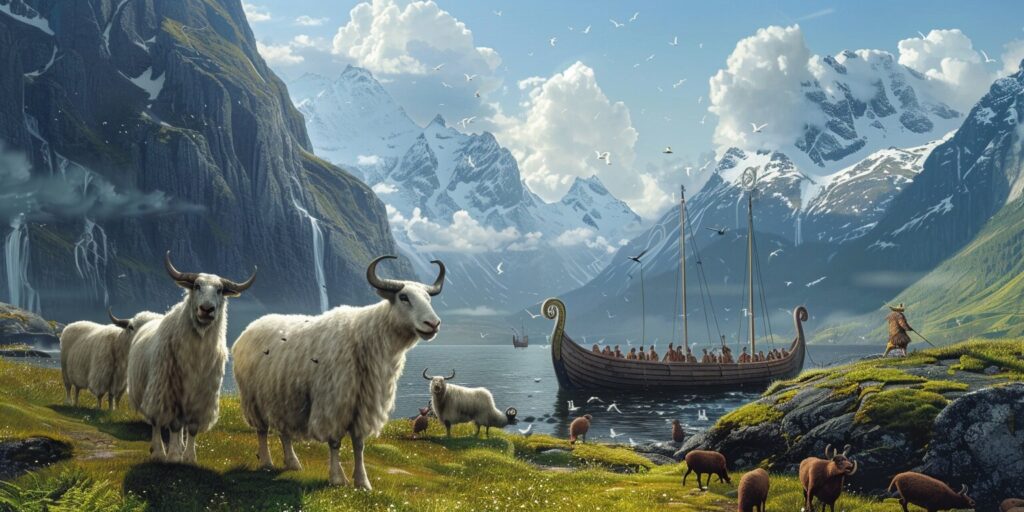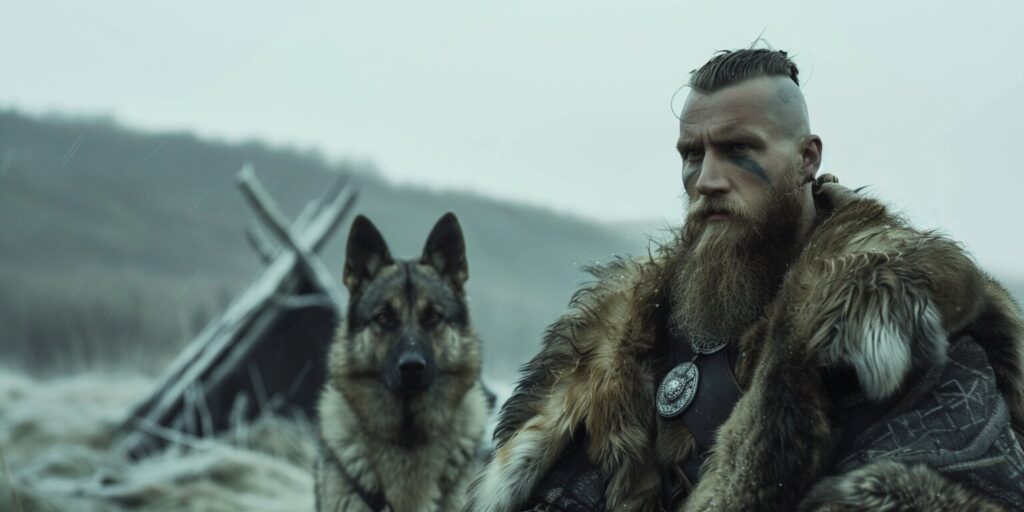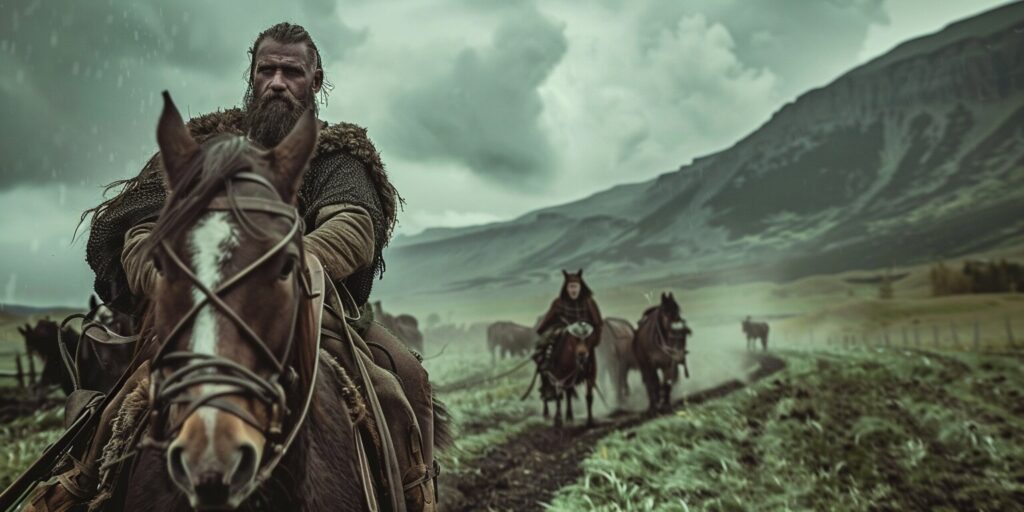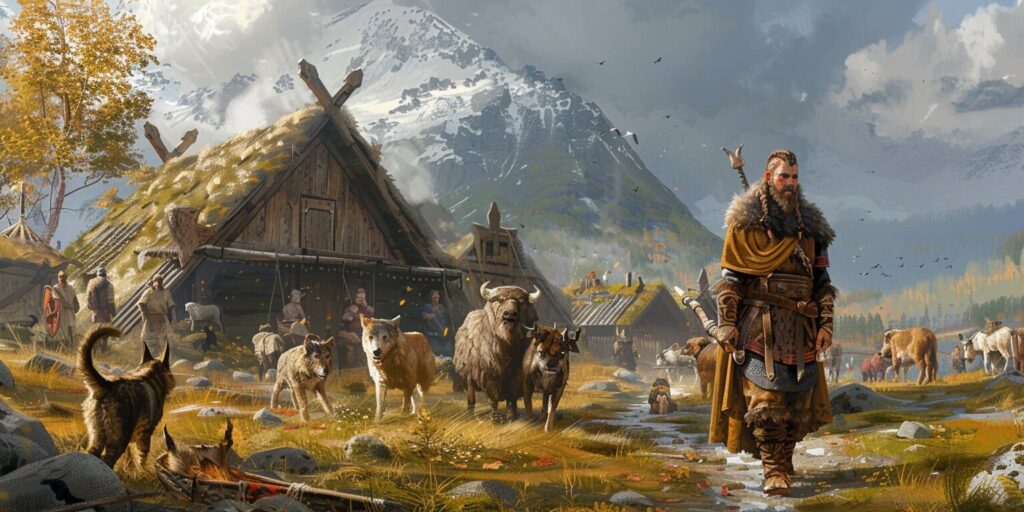Daily Life in the Viking Age, Tales of the Gods, Vikings
Furry Companions & Beasts of Burden: The Vikings’ Domesticated Animals and Pets
Welcome to our exploration of the fascinating relationship between the Vikings and animals in their everyday lives. In this article, we will delve into the diverse array of domesticated animals and pets that were an integral part of Viking society. From farm animals to beloved furry companions, the Vikings relied on these creatures for sustenance, labor, and companionship.
But did the Vikings keep pets? Were there animals solely reserved for companionship and emotional support? We will delve into this question and uncover the truth behind the existence of Viking domestic animals and pets. Through historical evidence and literary sources, we will decipher the bonds forged between Vikings and their animal companions. Join us on this journey as we explore the profound relationship between the Vikings and their furry friends. Prepare to uncover the inherent connection between these ancient seafarers and the creatures that shared their world.
Viking Society and Animals
In Viking society, animals played a prominent role and were deeply intertwined with their culture. The Vikings valued animals for their practical uses as well as their spiritual significance.
Viking Society Pets
One aspect of the Viking relationship with animals was the keeping of pets. While it is unclear if the Vikings had specific animals solely for companionship, evidence suggests they formed attachments to certain animals. Dogs, in particular, were valued companions and were often referred to as “man’s best friend.” These loyal animals would accompany the Vikings on hunts and serve as guards and protectors.
Viking Religious Beliefs and Animals
Viking religious beliefs also played a significant role in their interactions with animals. Animals were often associated with Norse gods and goddesses, and certain animals were considered sacred. The wolf, for example, was closely connected to Odin, the chief god of the Norse pantheon. The Vikings believed that Odin would send his wolves to aid in battle.
Viking Era Pets
In addition to their practical uses and religious associations, animals were also a source of inspiration for Viking art and storytelling. They were depicted in intricate carvings, tapestries, and jewelry, showcasing the deep connection between Viking culture and the animal kingdom.
- Animals were commonly depicted as symbols of strength, courage, and leadership.
- Mystical creatures like dragons and serpents were also featured, often representing the Viking warriors’ fearsome reputation.
Viking Culture Animals
Animals were admired for their physical attributes and believed to possess certain qualities that the Vikings respected and aspired to embody. For example, bears were seen as symbols of ferocity and bravery, traits that the Vikings highly valued in battle.
The Vikings’ deep appreciation for animals and their multifaceted relationship with them shed light on their importance in Viking culture. Whether as pets, symbols, or sources of inspiration, animals left an indelible mark on Viking society.
Farm Animals in Viking Life
Viking farm animals played a central role in everyday life and were vital to the agricultural practices of the time. The Vikings commonly raised a variety of animals on their farms, each serving a specific purpose and contributing to the sustenance and economic prosperity of the community.

Cattle
The Vikings highly valued cattle for their ability to provide milk, meat, and hides. They were a symbol of wealth and were often used as currency in Viking society. Cattle also played a significant role in religious ceremonies and were considered sacred.
Sheep
Sheep were another important farm animal for the Vikings. They were primarily raised for their wool, which was used to produce warm clothing, blankets, and other textiles. Sheep were also a source of meat and milk. The Vikings relied on sheep for their textiles and sustenance.
Pigs
Pigs were commonly found on Viking farms and were highly valued for their meat. Pork was a staple in the Viking diet and was consumed in various forms. Pigs were also useful for their ability to forage and root in the earth, making them efficient at clearing land for farming.
Chickens
The Vikings kept chickens for their eggs and meat. They provided a reliable source of protein and were easier to maintain compared to larger animals. Chickens were commonly raised in small numbers, with each farm having a coop for housing them.
These Viking farm animals formed the backbone of their agriculture, providing sustenance, materials, and economic stability. The Vikings’ deep understanding and effective utilization of these animals allowed them to thrive in a challenging environment and establish prosperous communities.
Domesticated Animals as Working Companions
The Vikings, known for their seafaring expeditions and resilient warrior culture, relied on a variety of domesticated animals for their daily tasks and survival. These animals played essential roles as working companions, aiding the Vikings in various aspects of their lives.
Dogs for Herding and Hunting
The Vikings highly valued dogs as working animals. They were trained for herding livestock, such as sheep and cattle, and were essential in managing and protecting the Viking farms. These intelligent and loyal creatures formed close bonds with their Viking owners and were crucial for maintaining order in the domestic sphere.

Additionally, dogs played a key role in hunting activities. The Vikings utilized their keen sense of smell and agility to track and capture game, enhancing their ability to gather food and resources.
Horses for Transportation and Farming
Another vital working companion for the Vikings was the horse. These majestic creatures provided the Vikings with efficient and swift transportation, enabling them to navigate vast distances during their voyages and expeditions.
Furthermore, horses were instrumental in farming tasks. Vikings used them to plow fields, carry heavy loads, and assist in other agricultural activities. The horses’ strength and endurance made them valuable assets in the labor-intensive farming practices of the Viking era.

Through the mutually beneficial relationship between humans and animals, the Vikings harnessed the power and abilities of their domesticated companions for various practical purposes.
In the next section, we will explore whether the Vikings kept pets and delve into the historical evidence and sources that shed light on this fascinating aspect of Viking culture.
Viking Pets: Fact or Myth?
One intriguing aspect of Viking civilization that has piqued the curiosity of historians and animal lovers is whether the Vikings kept pets. By delving into historical evidence and deciphering literary sources, we aim to shed light on this captivating topic.
The Vikings were known for their close relationship with animals, relying on them for various purposes such as farming, transportation, and hunting. But did they also keep animals solely for companionship? Was the concept of pets familiar to the Viking culture?
Examining the available historical accounts, we find mentions of animals in Viking households that were clearly considered more than just working companions. Dogs, for instance, were utilized for herding livestock and guarding properties and served as loyal and affectionate pets to their Viking owners.
While dogs seem to have been the most common pets among the Vikings, there are also indications of other animals being kept for companionship. Archaeological excavations have unearthed small animal remains, such as birds and rats, buried alongside humans, suggesting they held a special place in Viking households.
Additionally, sagas and legends recount tales of Norse gods and heroes sharing unique bonds with animals, further hinting at the possibility of Viking pet ownership. These mythical accounts often portray animals as integral characters, emphasizing their significance in Norse mythology and culture.
The Bond Between Vikings and Animals
When it comes to the Vikings, their relationship with animals went far beyond mere ownership. These seafaring warriors formed deep emotional connections and relied on domesticated animals for essential aspects of their daily lives.
For the Vikings, animals were a means of survival and companions who provided comfort and solace in the harsh Norse environment. Animals played an integral role in their lives, whether it was a loyal dog by their side during long journeys or a gentle horse helping them plow the fields.
The mutual benefits of this bond were not limited to emotional support alone. Vikings understood the practical advantages of having domesticated animals. They relied on cattle and livestock for food, clothing, and materials. Farm animals were essential for agriculture, providing milk, meat, and wool.
Furthermore, Vikings recognized the responsibilities that came with their ownership of animals. They had to care for their animals, ensuring they were properly fed, sheltered, and protected from predators. In return, these animals served as valuable assets, helping the Vikings thrive in their daily endeavors.
- Anglo-Saxon Chronicle: A historical document providing insight into Viking society and their animal interactions.
- Njals saga: An Icelandic saga that features animal companions and their significance in Viking culture.
- The Sagas of Icelanders: A collection of sagas that offer glimpses into the Vikings’ relationship with animals through vivid narratives.
Although the Vikings were known for their fearsome reputation, their bond with animals reveals a softer, more nuanced side to their character. They cared for and valued their furry companions and beasts of burden, recognizing these animals’ profound impact on their lives.
Conclusion
The Vikings had a deep connection and reliance on animals as domesticated pets and vital companions in their daily lives. Viking pet ownership was common and played a significant role in their society. Norse pets were cherished members of their households, providing companionship, protection, and assistance in various tasks.
From the farms to the battlefields, Vikings valued their domesticated animals. They recognized the unique abilities of dogs, which served as loyal herders and skilled hunters. On the other hand, horses were essential for transportation and farming, enabling the Vikings to navigate their vast lands and carry out crucial agricultural activities.
This complex relationship between the Vikings and their animals extended beyond practicality. Their emotional bond was evident, as they understood the mutual benefits of their partnership. Viking pet ownership exemplified their deep respect for nature and the interconnectedness of all living creatures.
Overall, the Vikings’ respect for animals and willingness to incorporate them into their daily lives are testaments to their profound role in Viking society. The bond between the Vikings and their domesticated animals, including pets, was not merely one of necessity but of mutual trust, companionship, and shared responsibility.

